JET in Fukushima
Festivals in Fukushima
M A J O R F E S T I V A L S I N F U K U S H I M A P R E F E C T U R E
Fukushima has a fantastic array of traditional, amazing festivals that date back generations. While here, be sure to check out as many of them as you can! Some, such as the naked man festival, invite foreigners to participate, giving people a wonderful opportunity to get involved in a way they never thought possible. Read below for a brief introduction to some of the main festivals in Fukushima. Keep in mind that each and every little town around the prefecture has their own local festivals also, at different times through out the year - be sure to keep an eye out for them!
|
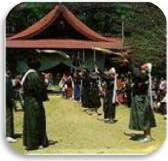
|
Ryozen Shrine Grand Festival, Date City (April)
This festival celebrates the history of the turbulent Nanbokucho (Northern and Southern Court) Period (1336-1392) , when the conflict between rival Imperial courts divided the nation. Several young men in samurai costume offer the Sword Dance to the local shrine deity. These young men, the Ranjo-burakutai, perform a ritualistic dance to enter the shrine, to the accompaniment of Japanese flutes and taiko. The swordsmen are followed in quick succession by four young girls with lion masks on their heads. The Shishi-no-mai (lion dance), with a history of 200 years, provides a quirky, light-hearted juxtaposition to the sword play.
|
|
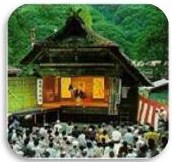
|
Hinoemata Kabuki Performance, Hinoemata Village(May & August)
Begun in the 18th century, this kind of Kabuki performance by farmers is rarely seen nowadays. In Hinoemata rural kabuki re-enacts tales of the medieval Taira (Heike) clan, whom the villagers claim as their ancestors. Originally, when boys became 15 years old, they were allowed to join kabuki. In rural kabuki it is not unusual to see women playing female roles although mainstream kabuki theatres have only male actors. When the story rises to a climax, the actors strike a mie pose and stand like statues. This is the highlight of their performance.
|
|
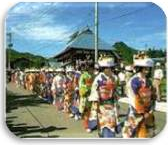
|
Tajima Gion Festival, Minamiaizu Town (July)
In this festival, which dates back 800 years, men wearing traditional kamishimo attire and young women dressed in bridal costumes, all carrying offerings of rice wine and festival foods, parade through the town to the local shrine. On the first day floats are paraded around Tajima carrying townspeople who play music and perform Kabuki plays. The second day is considered the highlight by many, and is when the young men and women parade in traditional attire, carrying offerings to the local shrines. The final day of the festival is filled with sacred music and dancing.
|
|
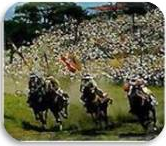
|
Soma-Nomaoi Festival, Soma City, Minamisoma City (July)
Dating back 1,000 years, this festival has been handed down in places that once belonged to the Soma clan. It spectacularly recreates the atmosphere of the Warring States Period (1467-1568). Some 500 horsemen in samurai costumes scramble for shrine flags, which are shot into the air with a burst of fireworks. The Soma-Nomaoi is said to have its origins in the early 10th Century when samurai warriors of this land secretly commenced their military exercises. Overseas, this event is considered to be one of Japan's most representative festivals.
|
|
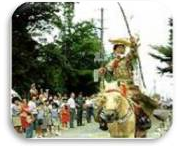
|
Yabusame, Iino Hachiman Shrine, Iwaki City (September), Furudono Hachiman Shrine, Furudono Town (Second Weekend in October)
Once a sport practiced by the samurai warriors of ancient times, Yabusame (mounted archery) is demonstrated nowadays as a shrine event dedicated to the local shrine deity. Mounted archers dressed in traditional costume, ride their horses at full gallop and fire arrows at a small target along their route. Great fun to watch!
|
|
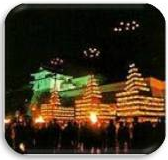
|
Nihonmatsu Lantern Festival, Nihonmatsu City (October)
This festival, which began in 1660, is highlighted by a parade of 7 festival floats, each displaying numerous lanterns that resemble ripe rice crops. It is known as one of the 3 largets lantern festivals in Japan. Each float has taiko drums inside that beat loudly during the procession, and over 300 lit lanterns decorate the structure. The festival is held to ensure a bumper rice harvest by cheering up the gods of the Nihonmatsu Shrine, in the hope they will bless the rice crop.
|
|
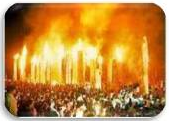
|
Taimatsu-Akashi Festival, Sukagawa City (Second Saturday in November)
This fire festival, one of the three greatest in Japan, is dedicated to consoling the spirits of victims of an event that took place some 400 years ago - the capture of Sukagawa Castle by Lord Masamune Date. During the day, processions of people carry large torches up to 8 or so meters in length and weighing hundreds of kilos around the city. As evening falls, the torches are set alight, lighting up the night sky.
|
|
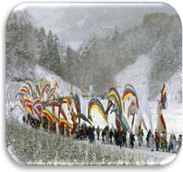
|
Kohata Banner Festival, Nihonmatsu City (First Sunday in December)
The Kohata Banner Festival originates from “Zen Kunen no Eki” or Earlier Nine Years' War (1051-1062). When Minamoto no Yoriyoshi and his son Yoshiie were defeated by Abe no Sadato, they took flight in to the mountains with a few vassals and made a prayer for winning the battle. During the night it snowed so much the mountains were covered. Abe no Sadato, who saw this in the next morning, mistook it for white flags and returned without fighting, which led to the victory of the Minamoto forces who were successfuly able to bring Mutsu Province under control. The festival is counted as one of top three Banner Festivals in Japan. The men in Yamabushi (mountain practitioner) costumes carry large banners in five colors of white, red, blue, yellow and pink, and march along the ridge of Mt. Kihata, blowing horagai (conch-shell trumpets).
|
|
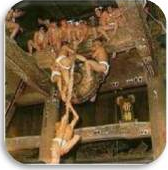
|
Nanokado Hadaka-Mairi Festival, Yanaizu Town (January)
At the sound of the day's first temple bell, young townsmen clad only in loin-cloths rush to climb up a thick rope to the ceiling of the main sanctuary of Nanokado Temple, scrambling to capture a holy charm that is believed to bring good luck. The festival is said to have originated from a local legend in which peasents chased away an evil dragon that lived in a near-by river. People participate in the festival to purify themselves and bring good luck in the coming year. Because the festival takes place in mid-winter it is often snowing which makes it that much more difficult for the participants. This unusual festival is well-known throughout Japan.
|
|
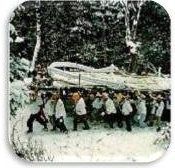
|
Shinobu Sanzan Akatsuki-mairi Festival, Fukushima City (February)
In this unique festival, celebrants carry a huge straw sandal, 12 meters long and weighing two tons, to Haguro Shrine on Mt. Shinobu. There, the sandal is offered in prayer in return for such things as a bountiful harvest, good physical health, traffic safety, success on examinations, success in marriage, and safety for one's family. The festival dates back to the Edo period (1600 - 1867), and has been a tradition in Fukushima for over 300 years!
|
|
















